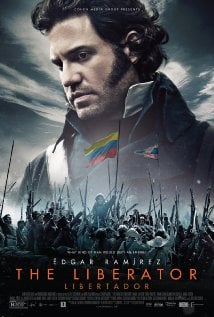
The lavish war epic comes back to life is this swashbuckling tale of treachery and charisma.
 Venezuelan actor Édgar Ramírez stars in Alberto Arvelo’s lavish production of the life, victories and eventual end of the revolutionary hero Simón Bolívar. Reminiscent of the stereotypical Roman and Viking war flicks, Arvelo skillfully ups the ante with high tech innovations to produce one of the largest independent film productions ever mounted in South America. Although Ramírez looks a little too handsome, young and dashing throughout all his trials and tribulations, strong performances by him and the supporting cast and the complete commitment of the production staff make this film work.
Venezuelan actor Édgar Ramírez stars in Alberto Arvelo’s lavish production of the life, victories and eventual end of the revolutionary hero Simón Bolívar. Reminiscent of the stereotypical Roman and Viking war flicks, Arvelo skillfully ups the ante with high tech innovations to produce one of the largest independent film productions ever mounted in South America. Although Ramírez looks a little too handsome, young and dashing throughout all his trials and tribulations, strong performances by him and the supporting cast and the complete commitment of the production staff make this film work.
Juggling 100 different sets must have been hard enough, but it is the 6,000 costumes that take this galloping juggernaut over the top. The film claims some 10,000 extras, although there was definitely some computer graphics involved ( especially in the recreated Spanish Armada). Nonetheless, all who have followed Bolivar’s unabashed chutzpah for the first half of the film will be horrified at the might that Spain threw against him. These were the folks who warmed up with the Spanish Inquisition a few hundred years before. They knew what to do with uncooperative upstarts.
Although Bolivar was born in Caracas, his family became very wealthy through centuries of cooperation with the Spanish crown, eventually controlling much of the copper production of Venezuela. His leadership in throwing off the reins of Spanish control marked him as a traitor of the worst kind. When aristocrats revolt, you know you have problems. His family must have been affected by this, but he had no children. Too bad, the effect of his decisions on his family’s fortunes is not addressed in the film.
The location shooting is sumptuous, including the site of Angel Falls, the world’s tallest waterfall, some 450 miles southeast of Caracas at the border of the Brazilian Amazon. The climax of the story is Bolívar’s trek over the Chilean Andes in the middle of winter. This move was aimed to take the superior Spanish forces in Columbia by surprise and it worked. His victory contributed substantially to the withdrawal of the Spaniards from Venezuela, Peru, Ecuador and Bolivia.
Nobody, then or now, could imagine marching thousands of ill clad and malnourished native soldiers through sub-zero temperatures across permanent glaciers. The toll on Bolivar’s forces was immense, but the effect of the victory turned the tide towards his dream of a united South American nation. This sequence was shot in Spain’s Sierra Nevada mountain range and combined with aerial location footage by visual effects supervisor, Rafael Solorzano.
Unskilled as a politician, Bolivar fell prey to the intricate working of very powerful people controlling the births of nations. The film leaves the question of his death open, but strongly suggests he was murdered. An investigation of his remains in July of 2010 uncovered no cause of unnatural death, supporting the official claim that he died in exile of tuberculosis.
In any event, the downfall of a charismatic leader is always prime fodder for an extravagant war story. This particular story is not lacking in gory battle scenes with plenty of bayonetting, squirming dying soldiers and piles of bodies. The Irish battalion sent by the British to “aid the revolution” (or was it to stab the Spanish as opportunity allowed?).
A heroic tale in the finest tradition, it is best to not dig too deep into this flick. Better to enjoy it for the unbridled revolutionary fervor that flows from the screen like water over the Angel Falls.